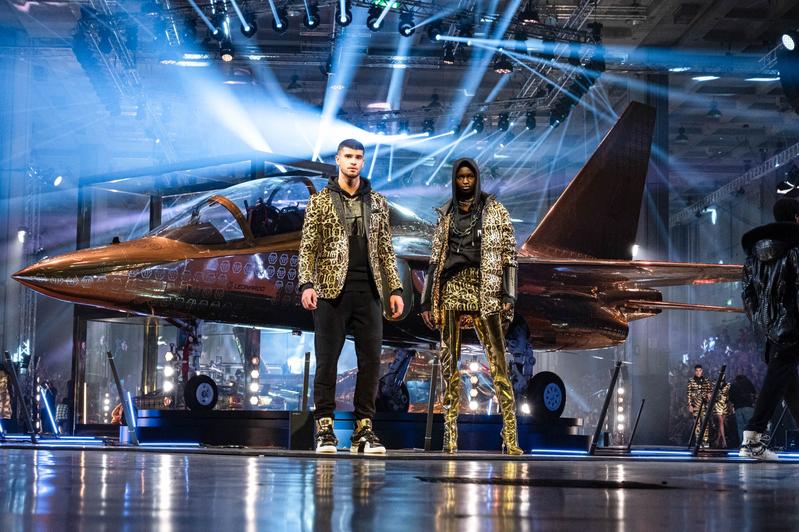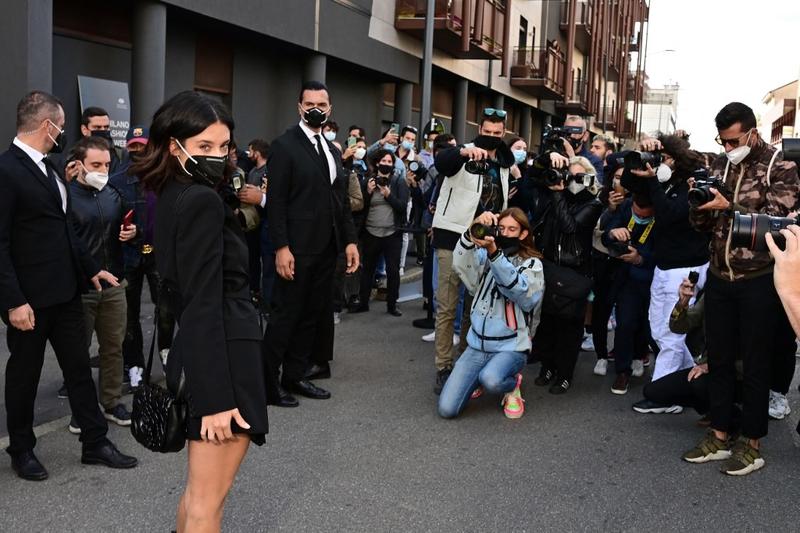 In this undated photo, two models pose during the Philipp Plein fashion show, part of Milan Fashion Week Fall/Winter 2020-2021, in February 2020. (PHOTO / BLOOMBERG)
In this undated photo, two models pose during the Philipp Plein fashion show, part of Milan Fashion Week Fall/Winter 2020-2021, in February 2020. (PHOTO / BLOOMBERG)
Each year over four weeks in February and March, thousands of fashion executives, celebrities, influencers and models hopscotch between the world’s style capitals to attend runway shows. Attached to them is a multimillion-dollar economy that pumps both investment and tourist spending into New York, London, Paris and Milan.
For the second season in a row, almost all runway shows during the fashion weeks in Milan, New York, London and Paris will be virtual this year
For the second season in a row, all of that has been erased by the pandemic. Almost all shows will be virtual, as they were last September. The luxury hotels normally packed with fashion’s finest will be near empty, local clubs and venues won’t be welcoming many for nightly parties, museum and art exhibitions will be ghost towns and high-end boutiques will miss out on the cash that flows from a flood of shoppers willing to shell out thousands for a dress or handbag.
All told, the four cities could miss out on more than US$600 million in economic activity this season, according to data compiled by Bloomberg.
ALSO READ: Fashion week makes history by going digital
Here’s a look at what it’s like on the ground in the world’s four prime fashion hubs as the industry braces for a second lost season:
New York
Not long after last February’s shows ended, New York City became the epicenter of the global coronavirus pandemic, leaving tens of thousands dead. A late-year resurgence in the Northeastern US led to renewed restrictions on business in Gotham, though infection rates have recently started to decline again. Nevertheless, New York’s fashion week, which began this past weekend, is being held virtually.
More than 100 events are on the calendar, from panels to presentations on live-streams and a few runway shows that actually include physical elements. Mainstays like Rebecca Minkoff and Jason Wu will take part as usual, and more than a dozen young designers will be spotlighted by the Black In Fashion Council.
 Model Gigi Hadid walks the runway for the Proenza Schouler fashion show during February 2020 - New York Fashion Week: The Shows at the Spring Studios in New York City, on Feb 10, 2020. (KENA BETANCUR / AFP)
Model Gigi Hadid walks the runway for the Proenza Schouler fashion show during February 2020 - New York Fashion Week: The Shows at the Spring Studios in New York City, on Feb 10, 2020. (KENA BETANCUR / AFP)
The Council of Fashion Designers of America said it expects business this spring to be tougher than last fall. “This season, even more than last, will be a great challenge for all of us as the world grapples with an increasingly devastating pandemic and economic downturn,” Tom Ford, chairman of the CFDA, wrote in a letter to the industry.
New York’s fashion week usually generates hundreds of millions of dollars in annual revenue, surpassing that of the US Open tennis tournament the city also hosts each year, according to the state legislature’s Joint Economic Committee. During normal times, they attract 150,000 attendees who fill Manhattan’s hotels, light up the night life and spend lots and lots of money.
London
It’s been a mixed start of the year for London, with a more easily transmitted virus variant forcing a third lockdown while the vaccine rollout raises hopes that another catastrophic surge can be avoided. The British Fashion Council is holding a digital-only event starting Feb 19 that will showcase both women and menswear by 95 designers — with names including Victoria Beckham.
London’s fashion week usually brings in more than £269 million (US$374 million) for the city, according to FashionUnited’s Business Intelligence. Oxford Economics estimates 240,000 direct jobs representing more than one-quarter of the UK fashion industry’s workforce have been lost because of the pandemic. Including indirect jobs, the toll spikes to 350,000.
 A model poses for photos backstage ahead of The Mark Fast show during London Fashion Week February 2020 in London, England, on Feb 18, 2020. (TRISTAN FEWINGS / BFC / GETTY IMAGES EUROPE VIA BLOOMBERG)
A model poses for photos backstage ahead of The Mark Fast show during London Fashion Week February 2020 in London, England, on Feb 18, 2020. (TRISTAN FEWINGS / BFC / GETTY IMAGES EUROPE VIA BLOOMBERG)
Back in 2011, nightclub owner Carlo Carello organized Roberto Cavalli’s fashion week party at the Battersea Power Station. He’s had to fire 80% of the staff at the Raffles club, an iconic venue in the posh Chelsea neighborhood. “We'd be heaving every night of the week, we’d normally have 2 or 3 fashion week parties on,” Carello said of pre-pandemic times. “A business like ours is being decimated.”
Making things worse is another malaise looming over the UK fashion industry: Brexit. Walpole, the organization representing luxury brands such as Burberry, said smaller fashion brands have stopped doing business with the European Union for the time being because “there’s an imperfect understanding” from country to country of duties that need to be charged, now that the UK is on its own.
Milan
When this year’s fashion shows begin in Milan on Feb 23, they will be fully digital, apart from a few presentations where a limited number of buyers and media have been invited to watch, socially distanced. Opening night will be an Instagram live party with a DJ set instead of an in-person blowout in a city that suffered some of the pandemic’s worst loss of life last spring.
To keep the city involved — and to allow passersby to watch live shows by icons such as Armani, Prada, Fendi and Dolce & Gabbana — the Italian Fashion Chamber will put up big screens in strategic locations across central Milan.
“It will be a symbolic gesture,” said Carlo Capasa, the chamber’s chairman and chief executive officer. “A reminder for the people of Milan that fashion is still part of everybody’s life, resilient despite the Covid crisis, still able to incarnate the city’s values: creativity and efficiency.”
In past years, each of the four Milanese fashion weeks would bring in about 30 million euros in spending at places like hotels and restaurants. Capasa expects that income to be cut by at least 80 percent.
 Spanish actress Maria Pedraza (left), wearing a face mask, poses as she arrives to attend the Valentino's Spring/Summer 2021 women's and men's show, during the Milan Fashion Week in Milan, Italy, on Sept 27, 2020. (MIGUEL MEDINA / AFP)
Spanish actress Maria Pedraza (left), wearing a face mask, poses as she arrives to attend the Valentino's Spring/Summer 2021 women's and men's show, during the Milan Fashion Week in Milan, Italy, on Sept 27, 2020. (MIGUEL MEDINA / AFP)
Paris
A year ago, Louis Vuitton’s Nicolas Ghesquiere set up his catwalk inside the Louvre, a monumental show that long-standing fashion filmmaker Loic Prigent described as “a swan song to COVID-free times.” Gone are the days when A-list celebrities would huddle in the front rows at the world’s the most visited museum. This time, the womenswear Paris Fashion Week will be an online affair. It kicks off on March 1.
The Institut Francais de La Mode estimates that Paris Fashion Weeks generated 450 million euros annually before the pandemic. While new estimates since the virus struck haven’t come out yet, the amount has predictably dropped, according to Pascal Morand, chairman of the Federation de La Haute Couture et de La Mode, which organizes the event.
Five of Paris’ 12 premier hotels, dubbed Palaces, are currently open, though with occupancy rates hovering between 5 percent and 15 percent, Christophe Laure, chairman of the UMIH Prestige hotel industry group said. During a normal pre-COVID-19 fashion week, all Palaces would be open with between 80 percent and 100 percent of their rooms booked. The situation “is pretty worrying,” Laure said.
Morand said COVID-19 has at least democratized access to the shows, thanks to their digital format — and the numbers show it. The Louis Vuitton’s fall menswear show by Virgil Abloh in January 2020 has been viewed just under 500,000 times on the brand’s YouTube page, whereas the 2021 show has already amassed more than double that amount.
Nevertheless, Morand looks forward to the day when traditional fashion shows return, since the digital experience “will never fully replace” the feeling of being there.


